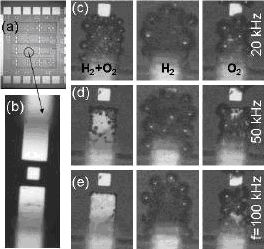Home > Press > Spontaneous combustion in nanobubbles
 |
| Formation of bubbles at the electrodes during electrolysis (can be seen in a and b). Situations c, d, and e show the formation of both hydrogen and oxygen on the left, hydrogen alone in the middle and oxygen alone on the right. Situation e shows combustion taking place on the left. No bubbles can be seen on the electrodes. |
Abstract:
Nanometre-sized bubbles containing the gases hydrogen and oxygen can apparently combust spontaneously, although nothing happens in larger bubbles. For the first time, researchers at the University of Twente's MESA+ Institute for Nanotechnology have demonstrated this spontaneous combustion in a publication in Physical Review E. They intend to use the phenomenon to construct a compact ultrasonic loudspeaker.
Spontaneous combustion in nanobubbles
The Netherlands | Posted on September 29th, 2011The fact that a violent reaction takes place is already evident from the damage incurred by the electrodes with which the reaction is initiated. These electrodes are used to make hydrogen and oxygen by electrolysis, in the usual manner, in an ultra-small reaction chamber. If the plus and minus poles are continually alternated, tiny bubbles containing both gases arise.
The frequency with which the poles are alternated determines the size of the bubbles: the higher the frequency, the smaller the bubbles. Combustion only takes place in bubbles that are smaller than 150 nanometres (a nanometre is a millionth of a millimetre); nothing happens in larger bubbles. Early experiments in microreactors also showed that nothing happened in larger bubbles; the heat can dissipate to the larger internal surface.
Metres per second
Researcher Vitaly Svetovoy was working on the construction of an actuator for rapidly building pressure when he came across this phenomenon. Such actuators are, for example, used in loudspeakers for ultrasonic frequencies undetectable by the human ear in the medical world. None of the mechanical techniques currently available are suitable for making a very compact loudspeaker of this kind and still achieving a ‘deflection' of metres per second on this scale. Svetovoy thought, however, that it might be possible by building up pressure with bubbles. The problem was that the bubbles could be made very rapidly but that they did not disappear quickly enough. The combustion reaction that has now been demonstrated might solve this problem. But it causes other problems too, such as the damage to the electrodes. "That is what we now have to look at", Svetovoy said.
This research was carried out by Prof. Miko Elwenspoek's Transducer Science and Technology group of the University of Twente's MESA+ Institute for Nanotechnology, see www.utwente.nl/ewi/tst/
Full bibliographic informationThe article ‘Combustion of hydrogen-oxygen mixture in electrochemically generated nanobubbles' by Vitaly Svetovoy, Remko Sanders, Theo Lammerink and Miko Elwenspoek appeared in Physical Review E on 23 September 2011
####
For more information, please click here
Contacts:
P.O. Box 217, 7500 AE Enschede, Netherlands
053-489 9111
053-489 2000
Wiebe van der Veen
+31612185692
Copyright © University of Twente
If you have a comment, please Contact us.Issuers of news releases, not 7th Wave, Inc. or Nanotechnology Now, are solely responsible for the accuracy of the content.
| Related News Press |
News and information
![]() Simulating magnetization in a Heisenberg quantum spin chain April 5th, 2024
Simulating magnetization in a Heisenberg quantum spin chain April 5th, 2024
![]() NRL charters Navy’s quantum inertial navigation path to reduce drift April 5th, 2024
NRL charters Navy’s quantum inertial navigation path to reduce drift April 5th, 2024
![]() Discovery points path to flash-like memory for storing qubits: Rice find could hasten development of nonvolatile quantum memory April 5th, 2024
Discovery points path to flash-like memory for storing qubits: Rice find could hasten development of nonvolatile quantum memory April 5th, 2024
Discoveries
![]() Chemical reactions can scramble quantum information as well as black holes April 5th, 2024
Chemical reactions can scramble quantum information as well as black holes April 5th, 2024
![]() New micromaterial releases nanoparticles that selectively destroy cancer cells April 5th, 2024
New micromaterial releases nanoparticles that selectively destroy cancer cells April 5th, 2024
![]() Utilizing palladium for addressing contact issues of buried oxide thin film transistors April 5th, 2024
Utilizing palladium for addressing contact issues of buried oxide thin film transistors April 5th, 2024
Announcements
![]() NRL charters Navy’s quantum inertial navigation path to reduce drift April 5th, 2024
NRL charters Navy’s quantum inertial navigation path to reduce drift April 5th, 2024
![]() Discovery points path to flash-like memory for storing qubits: Rice find could hasten development of nonvolatile quantum memory April 5th, 2024
Discovery points path to flash-like memory for storing qubits: Rice find could hasten development of nonvolatile quantum memory April 5th, 2024
|
|
||
|
|
||
| The latest news from around the world, FREE | ||
|
|
||
|
|
||
| Premium Products | ||
|
|
||
|
Only the news you want to read!
Learn More |
||
|
|
||
|
Full-service, expert consulting
Learn More |
||
|
|
||








